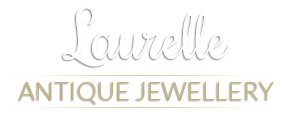A Brief History of Edwardian Jewellery
At Laurelle Antique Jewellery, we don’t just enjoy bringing you the most stunning antique jewellery, we love telling the stories behind it.
Our wide range of jewellery spans four periods and some pieces date back more than 200 years, so it’s fair to say that everything we offer is blessed with a rich history.
On this blog you can find posts on the brief history of all our antique jewellery periods, and in this post we’re tackling the intriguing Edwardian Era.
The Edwardian Era
The Edwardian Era, like the Georgian and Victorian Eras before it, is named after an English monarch.King Edward VII of Great Britain was the eldest son of Queen Victoria and Prince Albert and he reigned from 22nd January 1901 till his death on 6th May 1910 aged 68. The Edwardian period was the last to be named after a monarch.
Edward was in many ways the exact opposite of his mother Queen Victoria. In his younger days as a prince, he was known as a light-hearted, gambling playboy, and throughout his life, even into his relatively short reign as monarch, was known as someone who thoroughly enjoyed the luxurious lifestyle.
Edwards love of all things expensive extended to jewellery, and despite his short time as monarch, his influence on jewellery was definite and apparent. In fact, while his reign spanned from 1901-1910, there are examples of this influence towards the end of Victoria’s reign, and in the years after his death, leading up to World War I.
Fin De Siècle
The fin de siècle is the name given to the last decade of the 19th century, a time which set the base for Edwardian jewellery and style.
The 19th century saw the explosion of the Industrial Revolution in Great Britain. This meant that for the first time, products such as jewellery could be mass produced.
By the end of the century, consumers and creators began to reject the notion of mass producing jewellery, taking styles from large, pretentious but deficiently made to more delicate and ethereal and hand-crafted jewellery.
It was with these influences that during the turn of the century, Art Nouveau and the arts & crafts movements really began to come to the forefront of popular jewellery, and are styles which characterize much of this period.
Art Nouveau
While the arts & crafts movement is really a way of describing the change in the process of jewellery production, Art Nouveau has a distinctive stylistic approach and best helps describe the Edwardian Era.
At this time the Western world was becoming increasingly influenced by Eastern cultures, particularly Japan. The use of simple, elegant and beautiful interpretations of nature across fashion, art and jewellery became prominent in goods crafted in Europe.
The combination of Art Nouveau and arts & crafts saw jewellery pieces embrace both the elegant simplicity of the Japanese styles crossed with less traditional materials such as ivory, horn and moulded glass.
Also, the invention of the oxyacetylene torch in 1903 meant that for the first time temperatures could be achieved to work with platinum, making it another popular alternative base metal.
Shapes and Patterns
Partly down to the use of platinum (a strong but light metal) and partly down to changing tastes and styles, the use of laurel wreaths, knots, bows and ribbons became popular across every type of jewellery.
The appearance of something normally so delicate crafted into something appearing to be, except encrusted with gemstones was very popular.
Diamond and platinum brooches perfectly complemented the fashions of the day. Bows were more popular than ever, featuring on everything from brooches to rings and everything in between.
Dog collars also became popular, initially in France in the mid-to-late 1800s and then in Britain by the Edwardian Era. Often these would be made mostly of simple black velvet and then a buckle made of silver or platinum, with floral patterns and featuring diamonds.
There are plenty of examples of these many different trends and styles in our Edwardian Era section.

